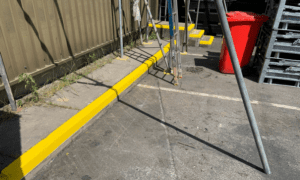
Did you know in the UK there is a trip on stairs every 90 seconds? In 2015 there were 787 deaths in England and Wales caused by a fall on, or from, steps and stairs. One of the most tragic cases was a 12-year-old boy who died after he in a stairwell at school in 2017. source
In the workplace approximately 1,000 major accidents occur on workplace stairs every year; if the pitch and rise of stairs is different and causes them to be uneven this is the most likely cause of an accident as it’s easier for a person to trip or misstep.
Handrails are vital in the prevention of trips and falls on stairs and should be positioned correctly and give a firm support for the user. If stairs are less than 1m in width a handrail is only required on one side, any wider and there must be handrails on both sides.
The nosing and surface play a big role in the safety of steps and stairs. Curved nosing on the edge of the step makes it far more likely for someone to have an accident so it’s recommended to have square nosing in a contrasting colour. Ensuring that each step is slip resistant and free from obstacles also helps to prevent trips and falls. Depending on where the steps are located you may need a slip resistant coating or regular cleaning to keep them clear of contamination.
You health and safety officer should perform regular checks to ensure that the stair are in good shape and identify any wear and tear. If the stairs are internal or external and used when it’s dark good lighting is vital.
Of course it’s not just how good or well maintained the stairs are that plays a part; everyone using the stairs needs to take care. If someone is carrying something and cannot see clearly they may misjudge steps, if there are wires trailing someone could trip, or even just being distracted by a phone call or colleague could lead to an accident.
A lot of it is common sense, but as a business owner it’s vital to have health and safety covered. We provide a variety of health and safety markings, including painting the edge of steps and walkways. Find out how we can help you by getting in touch.
Visit the HSE website for more information on reducing the risk of falls on stairs.

